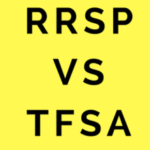 My latest MoneySense Retired Money column has just been published and looks at the twin topic of RRSPs that must start to be converted to a RRIF after you turn 71, and the related fact that the TFSA is a tax shelter you can keep adding to as long as you live. You can find the full column by clicking on the highlighted headline: How to make the most of your TFSAs in Retirement.
My latest MoneySense Retired Money column has just been published and looks at the twin topic of RRSPs that must start to be converted to a RRIF after you turn 71, and the related fact that the TFSA is a tax shelter you can keep adding to as long as you live. You can find the full column by clicking on the highlighted headline: How to make the most of your TFSAs in Retirement.
Unlike RRSPs, which must start winding down the end of the year you turn 71, you can keep contributing to TFSAs for as long as you live: even if you make it past age 100, you can keep adding $6,000 (plus any future inflation adjustments) every year. Also unlike RRSPs, contributions to Tax-free Savings Accounts are not calculated based on previous (or current) year’s earned income. Any Canadian aged 18 or older with a Social Insurance Number can contribute to TFSAs.
Once you turn 71, there are three options for collapsing an RRSP, although most people think only of the one offering the most continuity with an RRSP; the Registered Retirement Income Fund or RRIF. More on this below but you can also choose to transfer the RRSP into a registered annuity or take the rarely chosen option of withdrawing the whole RRSP at one fell swoop and paying tax at your top marginal rate.
Assuming you’re going the RRIF route, all your RRSP investments can move over to the RRIF intact, while interest, dividends and capital gains generated thereafter will continue to be tax-sheltered. The main difference from an RRSP is that each year you must withdraw a certain percentage of your RRIF and take it into your taxable income, where it will be taxed at your top marginal rate like earned income or interest income. This percentage start at 5.28% the first year and rises steadily, reaching 6.82% at age 80 and ending at 20% at 95 and beyond.
Some may be upset they are required to withdraw the money even if it’s not needed to live on. After all, you’re gradually being forced to break into capital, assuming you abide by some version of the 4% Rule (see this article.)
in 2020 only, you can withdraw 25% less than usual in a RRIF
For 2020 only, one measure introduced to cushion seniors from the Covid crisis was a one-time option to withdraw 25% less than normal from a RRIF; so if you turned 72 in 2020 you can opt to withdraw 4.05% instead of 5.4%.
RRIF owners with a younger spouse can base minimums on their age and also elect the 25% one-time reduction. Where both have RRIFs, both can take the 25% one-time reduction in 2020.
So how do TFSAs come into this? While you can’t avoid encroaching on your RRSP-turned-RRIF, there’s no rule that once having withdrawn the money and paid tax on it, you are obliged to spend it. If you can get by on pensions and other income sources, you are free to take the after-tax RRIF income and add it to your TFSA, ideally to the full extent of the annual $6,000 contribution limit. As of January 2021, the cumulative TFSA contribution room will be $75,500.


